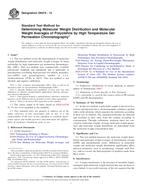We need your consent to use the individual data so that you can see information about your interests, among other things. Click "OK" to give your consent.
ASTM D3835-08
Standard Test Method for Determination of Properties of Polymeric Materials by Means of a Capillary Rheometer
STANDARD published on 1.12.2008
The information about the standard:
Designation standards: ASTM D3835-08
Note: WITHDRAWN
Publication date standards: 1.12.2008
SKU: NS-25036
The number of pages: 11
Approximate weight : 33 g (0.07 lbs)
Country: American technical standard
Category: Technical standards ASTM
The category - similar standards:
Annotation of standard text ASTM D3835-08 :
Keywords:
capillary, plastics, polymers, rheology, thermal flow, viscosity, Capillary rheometer method, Flow and flow rate--thermoplastics, Melt viscosity, Polymers, Rheology/rheological properties--plastics, Shear testing--plastics, Stress--plastics, Thermoplastics, Viscosity--plastics, ICS Number Code 83.080.20 (Thermoplastic materials)
Additional information
| Significance and Use | ||||||||||
|
This test method is sensitive to polymer molecular weight and molecular weight distribution, polymer stability—both thermal and rheological, shear instability, and additives such as plasticizers, lubricants, moisture reinforcements, or inert fillers, or combination thereof. The sensitivity of this test method makes the data useful for correlating with processing conditions and aids in predicting necessary changes in processing conditions. Unlike Test Method D 1238, which makes a one-point measure at a shear rate typically below processing conditions, this test method determines the shear sensitivity and flow characteristics at processing shear rates, and therefore can be used to compare materials of different compositions. |
||||||||||
| 1. Scope | ||||||||||
|
1.1 This test method covers measurement of the rheological properties of polymeric materials at various temperatures and shear rates common to processing equipment. It covers measurement of melt viscosity, sensitivity, or stability of melt viscosity with respect to temperature and polymer dwell time in the rheometer, die swell ratio (polymer memory), and shear sensitivity when extruding under constant rate or stress. The techniques described permit the characterization of materials that exhibit both stable and unstable melt viscosity properties. 1.2 This test method has been found useful for quality control tests on both reinforced and unreinforced thermoplastics, cure cycles of thermosetting materials, and other polymeric materials having a wide range of melt viscosities. 1.3 The values stated in SI units are to be regarded as standard. The inch-pound units given in parentheses are for information only. Note 1—Although this test method and ISO 11443–1995, “Plastic—Determination of the Fluidity of Plastics Using Capillary and Slit-Die Rheometers” differ in approach or detail, the data obtained using ISO 11443, Method A is technically equivalent to this test method 1.4 This standard does not purport to address all of the safety concerns, if any, associated with its use. It is the responsibility of the user of this standard to establish appropriate safety and health practices and determine the applicability of regulatory limitations prior to use. |
||||||||||
| 2. Referenced Documents | ||||||||||
|
Similar standards:
Historical
15.12.2012
Historical
1.6.2011
Historical
1.6.2011
Historical
1.6.2013
Historical
1.6.2011
Historical
1.1.2010
We recommend:
Updating of laws
Do you want to be sure about the validity of used regulations?
We offer you a solution so that you could use valid and updated legislative regulations.
Would you like to get more information? Look at this page.



 ASTM D6474-12
ASTM D6474-12 ASTM D6493-11
ASTM D6493-11 ASTM D6579-11
ASTM D6579-11 ASTM D6604-00(2013)..
ASTM D6604-00(2013).. ASTM D6605-06(2011)..
ASTM D6605-06(2011).. ASTM D6645-01(2010)..
ASTM D6645-01(2010)..
 Cookies
Cookies
